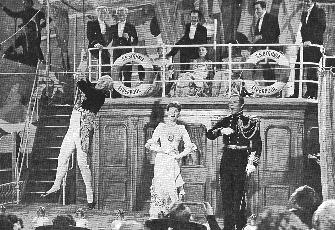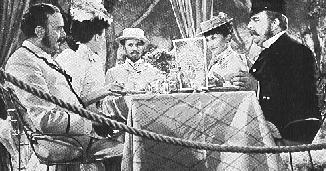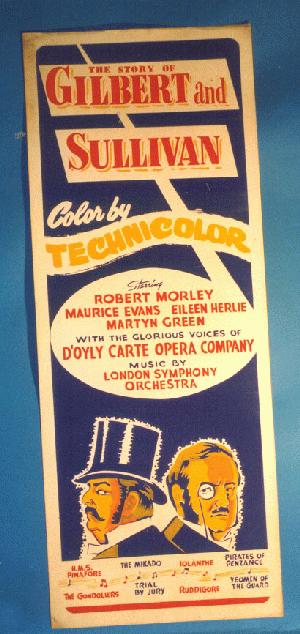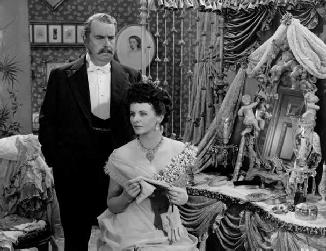The Story of Gilbert and Sullivan
(Technicolor Film, 1953)
| W. S. Gilbert | Robert Morley |
| Arthur Sullivan | Maurice Evans |
| Richard D'Oyly Carte | Peter Finch |
| George Grossmith | Martyn Green |
| Defendant, Nanki-Poo | Thomas Round |
| [for remaining cast, see below] | |
Written by: Leslie Baily, Sidney Gilliat and Vincent Korda
Cinematography by: Christopher Challis
Produced by: Sidney Gilliat and Frank Launder
Directed by: Sidney Gilliat
This film (also known, in the United States, by the title The Great Gilbert and Sullivan) is a reasonably faithful telling of the history of the G&S partnership. There are some gratuitous errors, but most of the historical inaccuracies are simply those needed to make this tale a compelling movie. At this the film succeeds spectacularly.
 George Grossmith as Sir Joseph Porter (Martyn Green), the principal soprano as Josephine (Ann Hanslip), and Rutland Barrington as the Captain (Eric Berry), perform a scene from H.M.S. Pinafore on their sea journey to the America. |
Richard Simonton told me that the film originally ran with an intermission between reels three and four (of five total), and reel four began with an explanatory title to pick up the thread of the story after the break. This shows how movie-going tastes have changed, for it is only about two hours long, and no theater would schedule an intermission for such a film today.
In any event, the narrative moves at such a perfect pace that one is scarcely aware of the passage of time. One needn't be a G&S fan to enjoy this yarn; those who are fans will love seeing the familiar story told with such care. The inclusion of extended passages from several D'Oyly Carte productions of the time (particularly Trial by Jury) is an added bonus.
 Sullivan announces that he is tired of his music playing second fiddle to Gilbert's words. Left to right: Maurice Evans as Sir Arthur Sullivan, Eileen Herlie as Helen Lenoir, Carte's secretary, Peter Finch as Richard D'Oyly Carte, Isabel Dean as Mrs. Gilbert, and Robert Morley as W. S. Gilbert. |
The film is based on Leslie Baily's The Gilbert and Sullivan Book, the most popular historical book on G&S ever written. Baily didn't hesitate to fictionalize parts of his book in order to make for a better story, and he doesn't hesitate in the film either. However, the film brilliantly conveys the spirit of what the G&S partnership was about, and historical scholars will forgive the occasional departures from historical fact in exchange for such a skillful storytelling job.
Richard Simonton says that the film was one of the first to be issued in stereophonic sound. I saw a showing of an original technicolor print at a Kentucky Opera symposium in the 1980s, and it was simply gorgeous. Even on the small screen, the viewer is amply rewarded. This is a film I can watch again and again.
 Poster for The Great Gilbert and Sullivan |
Comments by Jamie Moffat
 Poster for the The Story of Gilbert and Sullivan |
I'm interested in the passionate response that this film seems to trigger in some people. Having just sat through it again, uninterrupted, my feelings about it are clarified.
With any film of this age, it's important to place it in context. Films like The Story of Gilbert and Sullivan were relatively common in 1953. Popular biographies of celebrated musical figures were fairly common and covered a wide turf, from Cole Porter to Marjorie Lawrence. The Great Caruso, though by no means the first of the series, had a resounding box office success. In the same year as TSOGAS, there was a biopic of Nellie Melba starring Patrice Munsel and Robert Morley, who was getting around at the time! Wagner had his turn in Magic Fire. The films were unified by a few things. They were usually in chocolate box technicolor, they had a huge emphasis on the soundtrack, and they played with the facts, often to the point where the subject was unrecognisable.
Its easy to sneer at this school of film making; it certainly manufactured "culture" for the masses in a way that now seems at best condescending and at worst unacceptable. Much of what now seems suspect about the G&S film was just giving the audience what they expected. They were entertainment first. Educating the audience came in a very distant second; in fact I doubt that it was considered at all. Compared with some other examples of this school of film making, TSOGAS is accuracy itself.
 The Gilberts at Home — Robert Morley and Isabel Dean |
The irony is that since audience tastes have (inevitably) changed, TSOGAS can no longer hold a popular audience. Watching it with a group of non-G&S buffs it was astonishing how often the room dissolved into laughter at the film's archaic conventions and often hammy acting. Whilst I am the first to come leaping to the defence of old movies and did so in this case, I could see where they were coming from. As drama, per se, TSOGAS is dated and not especially diverting. (And yes, it does look a bit like Queen Victoria is reading the newspaper during The Golden Legend, though I know she's meant to be following the score. That scene got the biggest laugh of the night.)
What is encouraging though is how quickly the mood changed when the operatic scenes commenced. These were the moments that held the interest, rather than the framing device of the narrative — though of course one could hardly exist without the other. Ruddigore went down particularly well, and everybody in that room went toddling home with some G&S borrowed from my collection. So, TSOGAS still manages to communicate the delight of the Savoy Operas, and in this respect it is hugely successful.
On the whole I don't think its a bad film. Its just too hidebound by the conventions of the time to gather any momentum. Since I haven't seen Topsy-Turvy, I cannot make the comparison, nor am I clairvoyant enough to see how it will be perceived in 47 years. But like most films, it too will probably be showing its age.
Full Cast List
Peter Parker supplied the full cast list, taken from an "information folder which was originally issued about this film and which runs to some 452 pages of closely typed foolscap data":
| W.S.Gilbert | Robert Morley |
| Arthur Sullivan | Maurice Evans |
| Helen 'Lenoir' D'Oyly Carte | Eileen Herlie |
| Richard D'Oyly Carte | Peter Finch |
| George Grossmith | Martyn Green |
| Grace Marston | Dinah Sheridan |
| Mrs Gilbert | Isabel Dean |
| Mr Marston | Wilfred Hyde White |
| Queen Victoria | Muriel Aked |
| Louis | Michael Ripper |
| Joseph Bennett | Lloyd Lamble |
| Cellier | Richard Warner |
| Letty | Perlita Neilson |
| Smythe | Leonard Sachs |
| Theatre Manager | Philip Ray |
| Captain of the Bothnia | Ian Wallace |
| Ferguson | John Rae |
| Painter | Joe Clarke |
| Architect | Christopher Banks |
| Stage Manager | George Cross |
| Reporter | George Woodbridge |
| Pressman | Howard Douglas |
| Doorman | Robert Brooks Turner |
| Office Boy | John Quayle |
The following artists portrayed members of the original D'Oyly Carte Opera Company.
| George Grossmith | Martyn Green |
| Rutland Barrington | Eric Berry |
| Jessie Bond | Bernadette O'Farrell |
| Principal Soprano | Ann Hanslip |
| Principal Tenor | Anthony Snell |
| Principal Contralto | Muriel Brunskill |
| Principal Bass baritone | Owen Brannigan |
| Judge (Trial by Jury) | Harold Williams |
| Bride (Trial by Jury) | Yvonne Marsh |
| Defendant (Trial by Jury) | Thomas Round |
| Nanki Poo (The Mikado) | Thomas Round |
| Counsel (Trial by Jury) | Kenneth Downey |
| Gianetta and Peep-Bo | Sylvia Clarke |
| Ancestral Ghost (Ruddigore) | Gron Davies |
| Usher (Trial by Jury) | Arthur Howard |
| Pish Tush (The Mikado) | Kenneth Moseley |
| Strephon (Iolanthe) | John Banks |
| Bosun's Mate (H.M.S. Pinafore) | John Hughes |
| Midshipman (H.M.S. Pinafore) | Richard Morris |
The following singers' voices were used, not all of whom appeared on screen: Webster Booth, Elsie Morison, Marjorie Thomas, John Cameron, Grodon Clinton, Owen Brannigan, Harold Williams, Thomas Round, Muriel Brunskill, Jennifer Vyvyan, Joan Gillingham
| Date | Label | Format | Number |
|---|---|---|---|
| 1996 | Musical Collectables | VHS PAL, NTSC | [unnumbered] |
